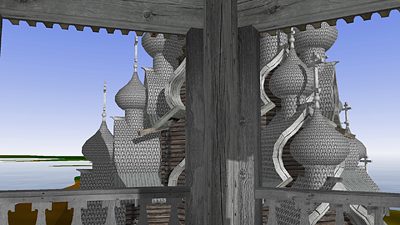Passing Place for Games
August 1st, 2007 - August 1st, 2009
Categories: Cultural Heritage, Multimedia, Museums, Visualization, VR, VR Art

About
Passing “Place for Games” visualizes the world famous Kizhi site as high-resolution 3D environment. The goal of this project is to create a virtual prototype of the current state of Kizhi wooden architecture. Kizhi museum preserves a concentration of masterpieces of the Russian heritage and protected by World Heritage List of UNESCO. The visualization reconstructs the original architecture of Kizhi island based on the detailed photographs, architectural and geometric measurements, textural data and video surveys taken during the visit of Kizhi as well as geometric analysis of the surviving structure. The project is being developed using the latest concepts in real-time graphics, including complex illumination with dynamic-irradiance environment mapping, shadow mapping, and complex materials with normal and gloss mapping.
Word “kizhi” is translated from Karelian as “a place for games.” In ancient times people gathered here and performed their religious rituals. Kizhi is located on an island in Lake Onega in northern Karelia in Russia. The Kizhi ensemble consists of the 1714 Church of the Transfiguration, the 1764 Church of the Intercession and the Belfry, an octagonal bell tower that was restored in 1874. A remote location, travel distance, limited building access due to restoration efforts make the Kizhi site difficult to visit. The visualization recreates virtual environment of the ensemble and the island landscape, animated historical evolution in the interactive high-resolution application controlled by the user.
The 3D architectural models restore the original state of the churches with geometrical precision and symmetrical balance. They are based on the architectural plans and high resolution and photographic and video data. The original symmetry of the churches was lost due to numerous restorations and environmental conditions.
The development approach is based on the latest techniques in real-time computer graphics techniques, including per-pixel illumination and shadow generation. Normal and gloss mapping are used for a richer, more detailed surface representation to visualize the details of the deteriorating wood with possible historic accuracy and photorealistic rendering. These techniques allow realistic re-creation of the material properties of the structures under different lightening effects with higher resolution and accuracy.